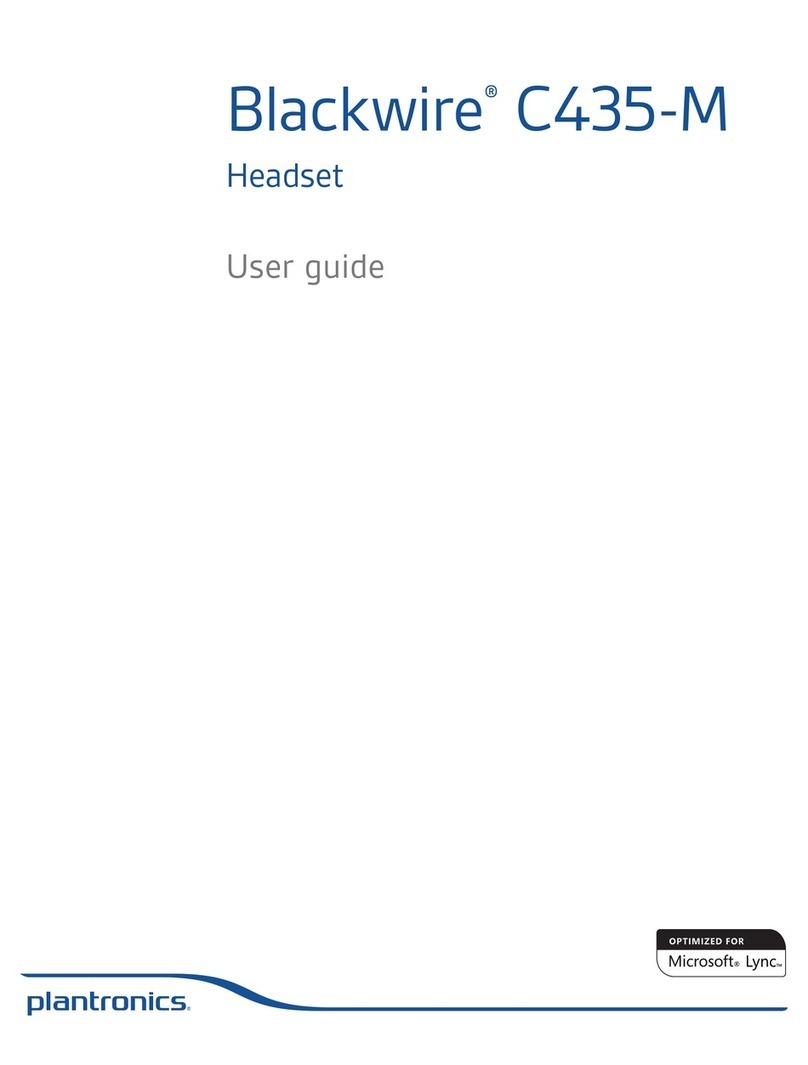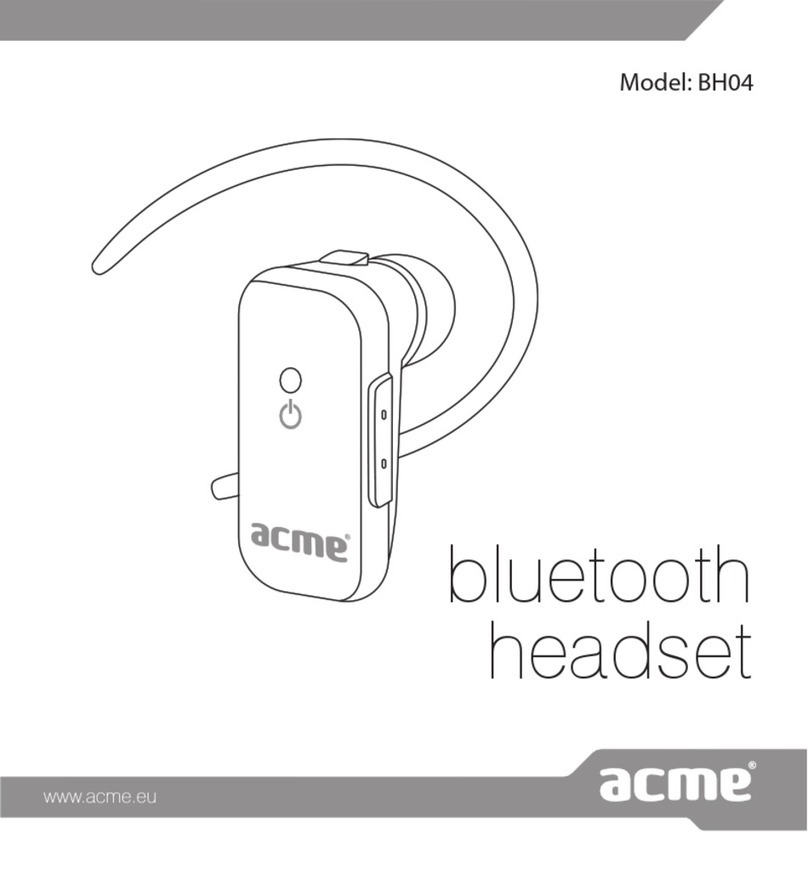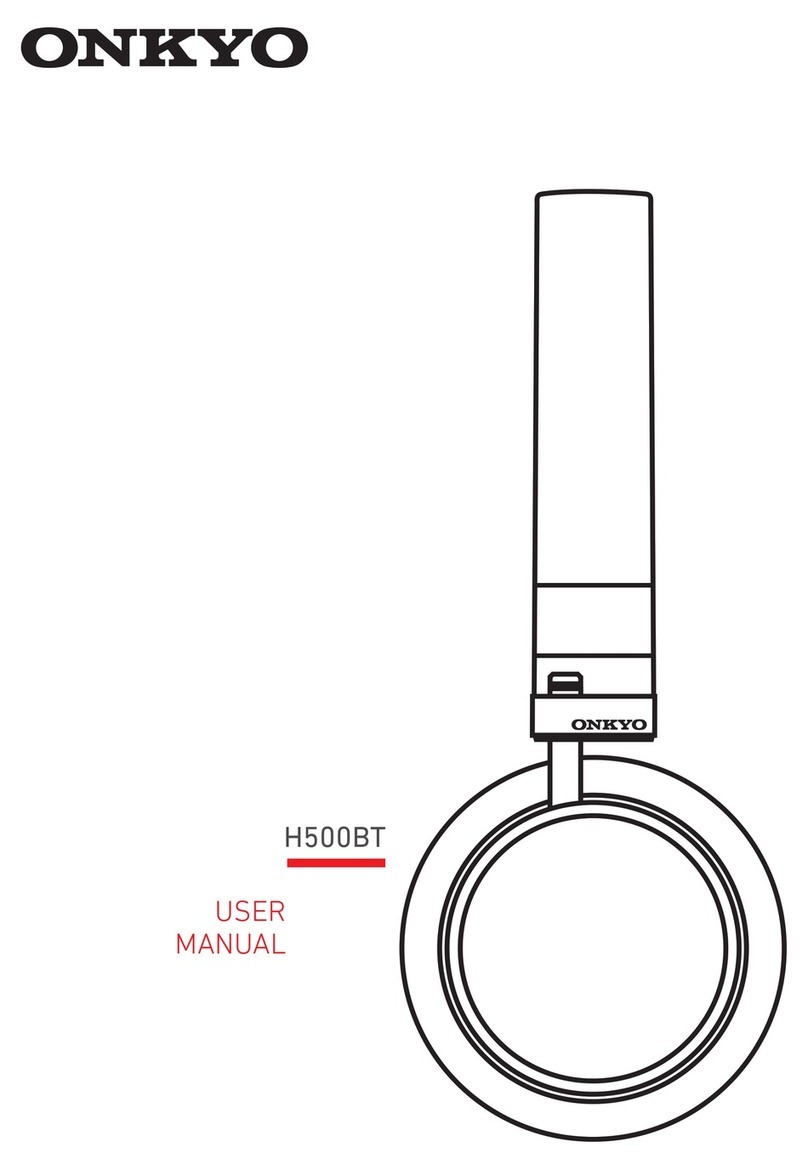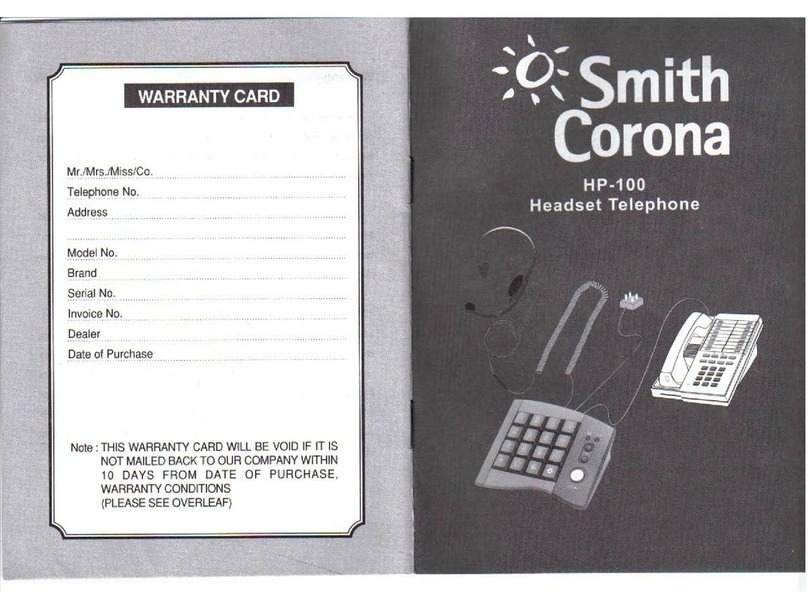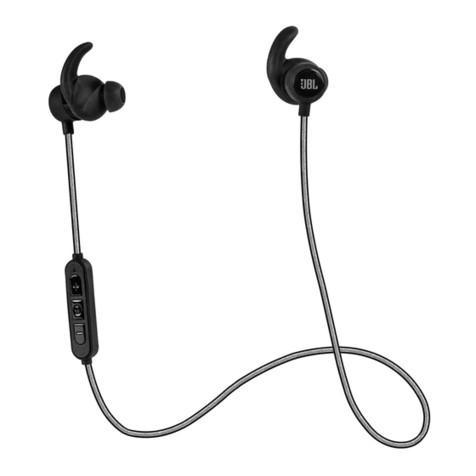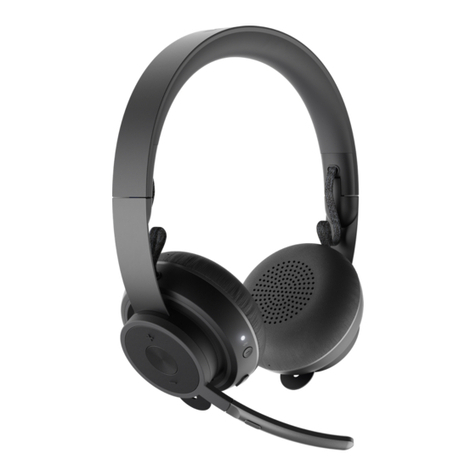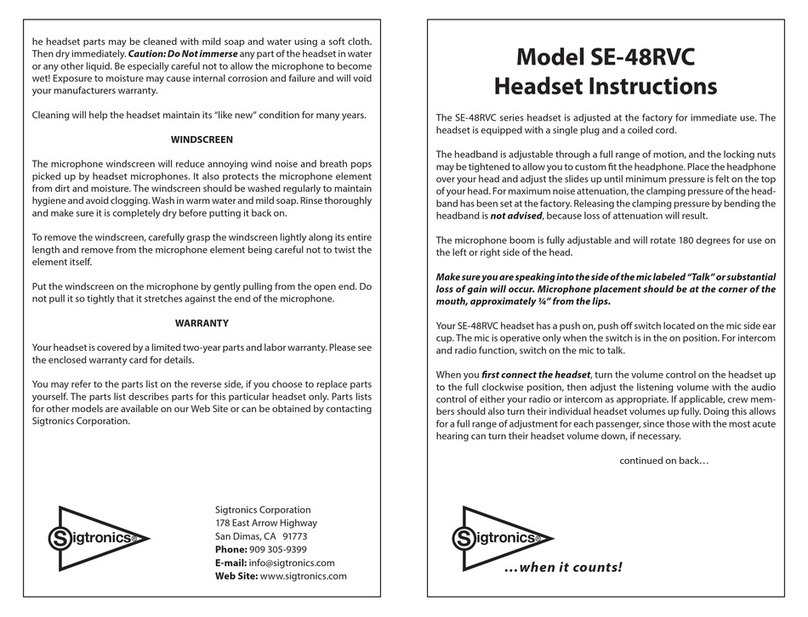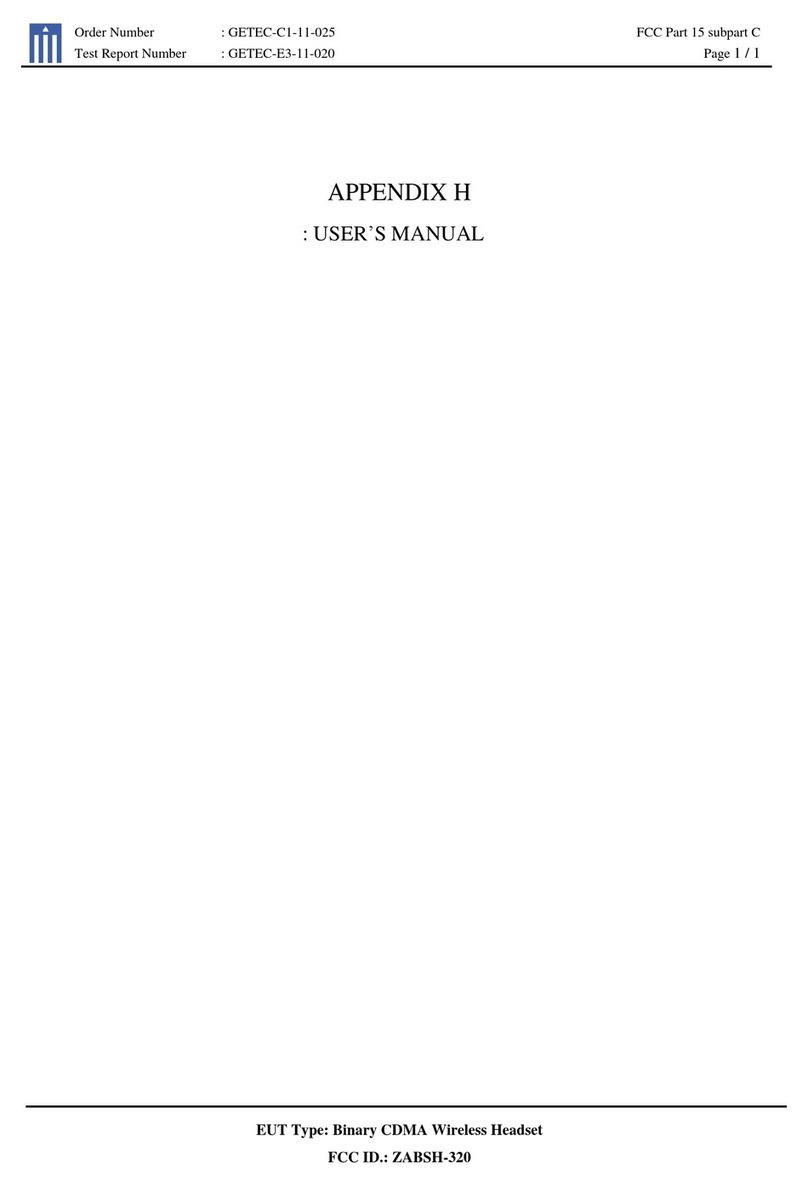Sens SM1P User manual

MANUAL
ENGLISH

DOC00078 SM1P Manual rev 01.5
2
En
glis
h INTRODUCTION
The SM1P
is a state of the art hearing protection communication
system that allows you to retain situational awareness whilst
remaining in full contact with your team via Short Range
technology, as well as two-way radio or cellular device
via
Bluetooth® or wired connection.
Situational awareness is provided by
processing technology
and environmental microphones mounted within the headset.
Contact through two-way
radios is enabled by the SRCK6
cable assembly available separately. Cable numbers
vary
depending on the two-
way radio model. Please consult with the
website for more information.
*SRCK61XX
part numbers vary depending on the radio connector.
Consult your supplier for the appropriate cable.
For language translated manuals and
further information, please
refer to the website.
is a state of the art hearing protection communication
system that allows you to retain situational awareness whilst
via
processing technology
and environmental microphones mounted within the headset.
radios is enabled by the SRCK6
1XX*
vary
way radio model. Please consult with the
part numbers vary depending on the radio connector.
further information, please

DOC00078 SM1P Manual rev 01.5
3
HEADSET ANATOMY
English
En
glis
h

DOC00078 SM1P Manual rev 01.5
4
En
glis
h FIGURE 1
#
Description
1.1 Volume up button
1.2 Volume down button
1.3 Power button
1.4 Hatch cover, for programming and charging
1.5 Multi-function button (MFB)
1.6 Headband*
1.7 Ear cushions
1.8 Microphones
1.9 Headset cable
1.10 Headset connector
1.11
Boom microphone
Mount - M5 Hex screw
Connector - 2.5mm Audio jack
1.12 Inline PTT
1.13 Inline PTT button
1.14 Two-way
radio connector (note, these will vary depending
on your two-way radio)
1.15 SRCK61XX cable assembly
1.16 To the two-way radio
1.17 LED light (one on each side of headset)
radio connector (note, these will vary depending

DOC00078 SM1P Manual rev 01.5
5
English
En
glis
h
WEARING THE HEADSET
FIGURE 2
#
Description
2.1 Headset
2.2 Boom microphone
2.3 Inline PTT
2.4 Two-way radio

DOC00078 SM1P Manual rev 01.5
6
En
glis
h WEARING THE HEADSET
The SM1P headset is designed to be worn with the headset sealing
around the ears. Specific examples of how to fit the headset around
the ears are covered in the next three pages. The fit does alter
slightly depending on what style of brace is used - headband,
behind the neck or mounted to a helmet directly.
The boom microphone should be placed approximately 5mm (1/4”)
in front of the mouth. Check to ensure the white dot or microphone
label is facing towards you. The orientation is essential as the
microphone is directional. If the microphone faces a different
direction, this may lead to a reduction in transmission quality.
The inline PTT has a rotatable clip behind it to allow it to attach to
the shirt / upper garment.
The inline PTT must be connected to the two-way radio using the
multi-pin connector.
FITTING THE HEADSET
It is recommended that the wearer should ensure that;
The ear muffs are fitted, adjusted and maintained in
accordance with the manufacturer’s instructions
The ear muffs are worn at all times in high noise conditions
If the above recommendations are not adhered to, the protection
afforded by the ear muffs will be severely impaired.

DOC00078 SM1P Manual rev 01.5
7
English
En
glis
h
BEHIND THE NECK MOUNT FITTING
INSTRUCTIONS
#
Description
3.1 Adjust velcro strap so that the ear muff cups completely
enclose the ears.
3.2
The ear muff cushions should seal firmly against the head.
3.3
For best results, remove all hair from under the ear cushion.
3.4
Noise reduction will be adversely affected by anything that
breaks the seal of the ear muff ear cushions.

DOC00078 SM1P Manual rev 01.5
8
En
glis
h
HEADBAND MOUNT FITTING INSTRUCTIONS
#
Description
4.1 Adjust the headband by pulling the centre band out equally on
both sides.
4.2
Ensure no hair is inside the muff ear cushions.
4.3 Fit the ear muffs over the ears ensuring a tight fit around the
ears.
4.4
Ensure the muff completely surrounds the ears.
4.5
Press down on the headband to obtain a snug and comfortable
fit.

DOC00078 SM1P Manual rev 01.5
9
English
En
glis
h
HELMET MOUNT FITTING INSTRUCTIONS
#
Description
5.1 Attach the adaptors to each side of the helmet by sliding them into the
slots.
5.2 Attach the earmuffs by sliding into the adaptors.
5.3 Ensure the earmuff is firmly attached by lifting the arm up and down.
5.4 Place the helmet on the head and adjust by sliding the ear muffs up and
down.
5.5 Earmuffs should seal firmly against the head. For best results, remove
hair from under the ear muffs.
5.6
Three adhesive mounts and ties are included to secure the ear muff
cable to the helmet. The mounts should be evenly spaced around the
rear outside of the helmet. Fit the tie through the mount. The cable
should feed through each tie and secured in place.

DOC00078 SM1P Manual rev 01.5
10
En
glis
h
OPERATING THE HEADSET
POWER ON:
1.
Press and release the “Power” button shown in Figure 1.
2. All the LEDs will turn on briefly, & an audible sound w
ill be heard
through the headset.
3. The Green L
ED will flash at a normal rate as described below.
POWER OFF:
1. Press and hold the “Power” button for 2 seconds.
2. All the LEDs will turn on briefly and a
n audible sound wi
heard through the headset as the headset powers off.
MODE:
When the headset is powered up, the unit is set into ‘
mode’**. By pressing the power button, this toggles ‘
‘
mode’ allows full situational awareness of your surroundings
in addition to two-way radio communications.
The power button toggles between Quiet mode
and mode
The volume control buttons can be used to raise or lower
the audio level of the mode.
**The default mode on
power up can be programmed
using the Sensear app.
QUIET MODE:
By pressing the power button, this toggles
‘Quiet mode’. Quiet
mode only allows two-
way radio communications to pass through
the headset.
mode
Green LED, blink twice every 4 seconds
Press and release the “Power” button shown in Figure 1.
ill be heard
ED will flash at a normal rate as described below.
n audible sound wi
ll be
mode’.
mode’ allows full situational awareness of your surroundings
The power button toggles between Quiet mode
The volume control buttons can be used to raise or lower
power up can be programmed
‘Quiet mode’. Quiet
way radio communications to pass through
Green LED, blink twice every 4 seconds

DOC00078 SM1P Manual rev 01.5
11
Quiet mode
Green LED, blink once every 4 seconds
SETUP MODE:
Setup mode
enables a limited number of settings to be changed
directly via the headset.
This mode is separate from the normal
headset operating mode.
Some options will not be available
product model does not support a feature
or headset programming
has removed the setup mode option
. For further setup, a
programming tablet will be required,
The options (with fully available feature set) are:
1. Short Range – region
2. Short Range – channel frequencies
3. FM Radio – enable/disable
4. VOX – feature assignment
5. VOX – trigger level
A short press and release of the power button will cycle through
these options when in setup mode.
Enter/exit setup mode:
1. Headset is powered off
2. Hold Volume Up button
3.
While holding Volume Up, Press & release Power button
4. Will hear “system setup”
5. Release Volume Up button
(short)
Cycle
down through system setup options
English
En
glis
h
Green LED, blink once every 4 seconds
enables a limited number of settings to be changed
This mode is separate from the normal
Some options will not be available
if the
or headset programming
. For further setup, a
A short press and release of the power button will cycle through
While holding Volume Up, Press & release Power button
down through system setup options

DOC00078 SM1P Manual rev 01.5
12
En
glis
h
(long)
Power off the headset.
The headset needs to be powered down before it can be powered
up into its normal operating mode.
Changes will be saved
powering off the headset from setup mode.
Changing Short Range region:
Ensure you hear “short range FM
region”.
/ (short)
Increment/decrement through regions
1, 2 or 3.
Region EIRP (uW) Standards
FM frequency range
(MHz)
1 8.02 AS/NZS 4268 88.1
–
2 0.048 EN301357-1 88.1
–
3 0.012 FCC-15.239 /
IC RSS-210 88.1
–
Changing Short Range frequencies:
Ensure you hear “short
range FM frequency”.
/ (short)
Change frequency:
up = increment 0.1MHz,
down = decrement 0.1MHz
The headset needs to be powered down before it can be powered
Changes will be saved
upon
Ensure you hear “short range FM
Increment/decrement through regions
FM frequency range
(MHz)
–
107.9
–
107.9
–
97.0
Ensure you hear “short

DOC00078 SM1P Manual rev 01.5
13
/ (long)
Change bank:
up = increment bank,
down = decrement bank
Note, frequency range is 88.1MHz to 107.9MHz (97.0 MHz for
region 3).
The frequency/bank last selected in the setup mode will be the
frequency/bank used when Short Range is turned on in normal
operating mode.
Changing FM radio enable:
Ensure you hear “FM radio”.
/ (short)
Toggle between “enable” and
“disable”.
Changing VOX assignment:
Ensure you hear “VOX setup”.
/ (short)
Toggle between “disable” and “Short
Range”
Changing VOX trigger level:
Ensure you hear “VOX level”.
/ (short)
cycle through
“low”, “medium” and
“high” trigger levels
“low” is the most sensitive/easiest to trigger VOX and “high” is the
least sensitive/hardest to trigger VOX.
English
En
glis
h
Note, frequency range is 88.1MHz to 107.9MHz (97.0 MHz for
The frequency/bank last selected in the setup mode will be the
frequency/bank used when Short Range is turned on in normal
Ensure you hear “FM radio”.
Toggle between “enable” and
Ensure you hear “VOX setup”.
Toggle between “disable” and “Short
Ensure you hear “VOX level”.
“low”, “medium” and
“low” is the most sensitive/easiest to trigger VOX and “high” is the

DOC00078 SM1P Manual rev 01.5
14
En
glis
h COMMUNICATING
COMMUNICATING OVER TWO-WAY RADIO:
To transmit over the two-way radio:
Press and hold the button located on the inline PTT.
Release the inline PTT button to cease transmission.
To change the volume of the two-way radio
communications, use the two-way
radio’s volume controls
Notes:
When
the headset is powered off (and disconnected from
the inline PTT), the inline PTT button may not activate the
two-way radio. The PTT located on the two-
way radio
should be used.
When the headset is powered on, the two-
way radio PTT
may not activate the two-way radio
COMMUNICATING OVER SHORT-RANGE:
+
(short press) together to toggle Short Range on
When on:
Short Range PTT
/ (long)
Increment/decrement preset frequency bank
W
hen the headset is powered off it remembers the last selected
frequency bank and the Short Range on/off state.
Press and hold the button located on the inline PTT.
Release the inline PTT button to cease transmission.
radio’s volume controls
the headset is powered off (and disconnected from
the inline PTT), the inline PTT button may not activate the
way radio
way radio PTT
(short press) together to toggle Short Range on
/ off.
Increment/decrement preset frequency bank
hen the headset is powered off it remembers the last selected

DOC00078 SM1P Manual rev 01.5
15
Short Range VOX: [See Operating the Headset -
Setup Mode
section for VOX setup information]
If VOX is assigned to Short Range, when Short Range turns on,
you will hear the Short Range frequency announcement
and then
“VOX on”. VOX can be toggled on and off:
+
[short)
Toggle VOX on and off (while Short Range
is turned on)
VOX does not trigger while there is an active signal on the Short
Range frequency. A VOX transmission can be interrup
ted by
pressing and releasing the Short Range PTT (i.e. MFB).
VOX will also not trigger when two-way is transmitting,
Bluetooth
in a phone call or when connected to a Bluetooth® radio.
LISTENING TO FM RADIO:
+ (short press) together to toggle FM
radio on /off.
Note, FM radio cannot be turned on while Short Range is turned on
and vice versa.
When on:
/
(long)
Scan up/down to the next FM radio.
English
En
glis
h
Setup Mode
If VOX is assigned to Short Range, when Short Range turns on,
and then
Toggle VOX on and off (while Short Range
VOX does not trigger while there is an active signal on the Short
ted by
Bluetooth
® is
radio.
radio on /off.
Note, FM radio cannot be turned on while Short Range is turned on
Scan up/down to the next FM radio.

DOC00078 SM1P Manual rev 01.5
16
En
glis
h
When a Bluetooth phone call is entered, FM radio audio is muted. It
will return when the call ends.
When the headset is powered off it remembers the last tuned FM
radio frequency and the FM radio on/off state.
COMMUNICATING OVER BLUETOOTH®:
First time pairing: Press and hold the multi-function button (MFB)
to put the headset into pairing mode. “Bluetooth® discoverable”
when pairing mode is entered. Will hear a connection tone if
connection successful. Pairing mode times out after 2 minutes.
Note, if Short Range is turned on, you must first turn it off to use the
MFB for Bluetooth® pairing (see Short Range section). After the
headset is in Bluetooth® pairing mode, Short Range can be turned
back on.
Reconnect: When powered on the headset will try to reconnect to
the last paired device. Alternatively, if the headset is not currently
paired to another device, prompt the reconnection from a device
(e.g. mobile phone that has the headset stored in its device list).
Incoming call Answer call:
a. From handset
b. Press and release MFB
Reject call:
a. From handset
b. Press and hold Multi-function button
During call End call:
a. From handset
b. Press and hold Multi-function button
c. Call hung up on the far end

DOC00078 SM1P Manual rev 01.5
17
Two-way radio Bluetooth®:
To transmit, use the radio’s PTT. For
some select device, MFB will perform as a Bluetooth®
PTT (if short
range off).
Contact Sensear representative for compatible devices.
Bluetooth® phone call: During a Bluetooth®
phone call, if two
radio or short range are transmitting, outgoing Bluetooth
®
while incoming audio is still heard. Once two-
way and Short Range
stop transmitting, outgoing Bluetooth® is restored.
Bluetooth® Audio streaming:
For Intrinsically safe headsets,
audio streaming can only be used in Quiet mode.
Streamed audio
will be mute in mode. T
his is often used for streaming music
but industrial use cases include Bluetooth®
machine health
analyzers.
Blue LED Indicator:
Solid Paring mode
Blinking slowly Paired
Blinking fast Incoming phone call
MAINTENANCE AND STORAGE
This product may be adversely affected by certain chemical
substances. Further information
should be sought from the
manufacturer.
The headset contains replaceable cushions (Part #: SMHK0000).
Cushions are recommended to be replaced every 3-
6 months to
maintain the appropriate hearing protection that the product is
certified to. Cushions should
be inspected regularly for signs of
damage or wear. Cushions can be removed simply by gripping the
cushion and pulling firmly to unclip from the baseplate.
Replacement cushions may be pushed into the clips around the
baseplate.
English
En
glis
h
To transmit, use the radio’s PTT. For
PTT (if short
phone call, if two
-way
®
is muted
way and Short Range
For Intrinsically safe headsets,
Streamed audio
his is often used for streaming music
machine health
This product may be adversely affected by certain chemical
should be sought from the
The headset contains replaceable cushions (Part #: SMHK0000).
6 months to
maintain the appropriate hearing protection that the product is
be inspected regularly for signs of
damage or wear. Cushions can be removed simply by gripping the
Replacement cushions may be pushed into the clips around the

DOC00078 SM1P Manual rev 01.5
18
En
glis
h
The headset should be stored at room temperature (between
15°C/59°F and 25°C/77°F).
ACCESSORIES AND SPARE PARTS
The following accessories and spare parts may be ordered
separately:
SRCK61xx
Various models, two-way radio interface cables for
most popular two way radios.
SMHK0000
Ear muff hygiene kits
SMBE0000
Behind-the-neck replacement band
SMBB0000
Headband replacement band
SMHA0001
SM1 Helmet Adaptor – MSA Vguard
SMHA0002
SM1 Helmet Adaptor – Protector Allsafe
SMHA0003
SM1 Helmet Adaptor – Protector Tuffmaster
SMHA0004
SM1 Helmet Adaptor – Unisafe Unilite
SMBM0001
Replacement boom microphone
SMAP0001
Cooling Pads
Further information may be obtained from your Sensear
representative, via the Sensear web site, or by emailing or writing to
the address on this User Manual.
CHARGING
The Sensear SM1P headset is supplied with an AC adapter that
operates globally when fitted with the appropriate electrical regional
adapter.
To charge the headset, follow the steps below:

DOC00078 SM1P Manual rev 01.5
19
English
En
glis
h
1. Plug the Sensear AC adapter into an appropriate power
outlet.
2. Insert the cable end of the Sensear AC adapter into the
DC power socket on the SM1P headset.
3. The LEDs will flash as indicated below:
Red LED blink twice every 5 seconds Battery low (< 1 hour left)
Red LED solid Charging
Green LED solid Charge complete
Notes on Battery and Charging:
Over 24 hours of battery life when fully charged.
Up to 7 hours for complete recharge.

DOC00078 SM1P Manual rev 01.5
20
En
glis
h DECLARATION OF CONFORMITY
We, the undersigned,
Company Sensear Pty Ltd
Address 199 Great Eastern Highway, Belmont, WA,
6104
Country Australia
Telephone
Number
+61 8 9277 7332
Fax Number +61 8 9277 7338
Web http://www.sensear.com
Email [email protected]
Declare that:
Model SM1P in accordance with the following directives:
2011/65/EU
1989/686/EEC
2014/53/EC
2014/35/EU
2014/30/EU
Has been designed and manufactured to the following
specifications:
ETSI EN 352-1, EN352-3, EN352-4 and EN 352-6
EN 301 489-1: V2.1.1 (2017-02)
EN 301 489-17: V3.1.1 (2017-02)
EN 300 328: V2.1.1 (2016-11)
EN 61000-6-2 Ed 3.0
EN 61000-6-3 Ed 2.1
Table of contents
